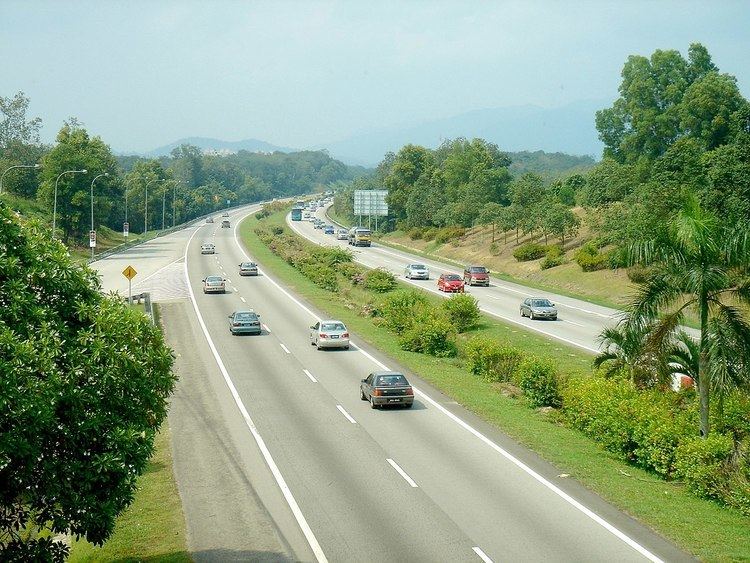 | ||
Transportation in Malaysia started to develop during British colonial rule, and the country's transport network is now diverse and developed. Malaysia's road network is extensive, covering 144,403 km, including 1,821 km of expressways. The main highway of the country extends over 800 km, reaching the Thai border from Singapore. The network of roads in Peninsular Malaysia is of high quality, whilst the road system in East Malaysia is not as well developed. The main modes of transport in Peninsular Malaysia include buses, trains, cars and to an extent, commercial travel on aeroplanes.
Contents
- Roads
- Railways
- Airports
- Airports with paved runways
- Heliports
- Airlines
- Waterways
- Ports and harbours
- Ferry
- Merchant Marine
- Pipelines
- References
Malaysia has six international airports. The official airline of Malaysia is Malaysia Airlines, providing international and domestic air service alongside two other carriers. Most of the major cities are connected by air routes. The railway system is state-run, and covers a total of 1,849 km. Popular within the cities is Light Rapid Transit, which reduces the traffic load on other systems, and is considered safe, comfortable and reliable.
Roads
Malaysia's road network covers 144,403 kilometres (89,728 mi), of which 116,169 kilometres (72,184 mi) is paved, and 1,821 kilometres (1,132 mi) is expressways. The longest highway of the country, the North-South Expressway, extends over 800 kilometres (497 mi) between the Thai border and Singapore. The road systems in Sabah and Sarawak are less developed and of lower quality in comparison to that of Peninsular Malaysia. Recently, the construction of Pan-Borneo Highway is approved under 2015 Malaysian Budget. The highway project span 1,663 km (936 km in Sarawak, 727 km in Sabah) mostly mirror the existing trunk road, and it involves the widening of the present three-metre wide single-carriageway into a dual-carriageway. Driving on the left has been compulsory since the introduction of motor vehicles in Federated Malay States in 1903 during British colonial era.
Railways
The railway system is state-run, and covers a total of 1,849 kilometres (1,149 mi). Most of the railway lines are consisted of ballasted setup, along with concrete sleepers, which serves better in wet and humid tropical condition, compared to wooden sleepers which can rot over time. As early as 1980s, due to the need for local suppliers of such products, a few local Malaysian rail manufacturing companies had been formed by collaboration with foreign technology partners.
1,792 kilometres (1,113 mi) of it is narrow gauge, while 57 kilometres (35 mi) is standard gauge. 767 kilometres (477 mi) of narrow gauge tracks and all of the standard gauge tracks are electrified. Intra-city travel is through relatively inexpensive elevated Light Rapid Transit systems and KTM Komuter are used in some cities, such as Kuala Lumpur. Currently, Malaysia is extending the existing LRT1 & LRT2 lines and work on new LRT3 and Mass Rapid Transit (MRT) lines already started. Malaysia already approved her first Kuala Lumpur–Singapore High Speed Rail project spanning 375 km between Kuala Lumpur and Singapore. This rapid development had spurred growth of local Malaysian rail service Companies which caters these niche needs.
Airports
Malaysia has 118 airports, of which 38 are paved. The national airline is Malaysia Airlines, providing international and domestic air services. Major international routes and domestic routes crossing between West Malaysia and East Malaysia are served by Malaysia Airlines, AirAsia and Malindo Air while smaller domestic routes are supplemented by smaller airlines like MASwings, Firefly and Berjaya Air. Major cargo airlines include MASkargo and Transmile Air Services. Kuala Lumpur International Airport is the main and busiest airport of Malaysia. In 2014, it was the world's 13th busiest airport by international passenger traffic, recording over 25.4 million international passenger traffic. It was also the world's 20th busiest airport by passenger traffic, recording over 48.9 million passengers. Other major airports include Kota Kinabalu International Airport, which is also Malaysia's second busiest airport and busiest airport in East Malaysia with over 6.9 million passengers in 2013, and Penang International Airport, which serves Malaysia's second largest urban area, with over 5.4 million passengers in 2013.
Airports with paved runways
total: 38
over 3,047 m: 5
2,438 to 3,047 m: 7
1,524 to 2,437 m: 10
914 to 1,523 m: 9
under 914 m: 7 (2004 est.)
Heliports
2 (2006 est.)
Airlines
National airline:
Other airline
Waterways
Malaysia has 7,200 kilometres (4,474 mi) of waterways, most of them rivers. Of this, 3,200 kilometres (1,988 mi) are in Peninsular Malaysia, 1,500 kilometres (932 mi) are in Sabah, and 2,500 kilometres (1,553 mi) are in Sarawak.
Ports and harbours
Malaysia is strategically located on the Strait of Malacca, one of the most important shipping lanes in the world. Malaysia has two ports that are listed in the top 20 busiest ports in the world, Port Klang and Port of Tanjung Pelepas, which are respectively the 2nd and 3rd busiest ports in Southeast Asia after the Port of Singapore. Port Klang is Malaysia's busiest port, and the 13th busiest port in the world in 2013, handling over 10.3 million TEUs. Port of Tanjung Pelepas is Malaysia's second busiest port, and the 19th busiest port in the world in 2013, handling over 7.6 million TEUs.
This is a list of Malaysian ports and harbours:
Ferry
Merchant Marine
Total: 360 ships (1,000 GRT or over) 5,389,397 GRT/7,539,178 tonnes deadweight (DWT) by type: bulk 59, cargo 100, chemical tanker 38, container 66, liquefied gas 25, livestock carrier 1, passenger 2, petroleum tanker 56, roll on/roll off 5, vehicle carrier 8
Foreign-owned: China 1, Germany 2, Hong Kong 8, Indonesia 2, Japan 2, South Korea 1, Liberia 1, Monaco 1, Norway 1, Philippines 2, Singapore 81, Vietnam 1
registered in other countries: 75 (2009 est.)
Pipelines
Malaysia has 3 kilometres (2 mi) of condensate pipeline, 1,965 kilometres (1,221 mi) of gas pipeline, 31 kilometres (19 mi) of oil pipeline, and 114 kilometres (71 mi) of refined products pipelines.
